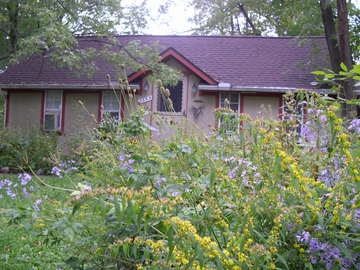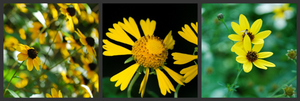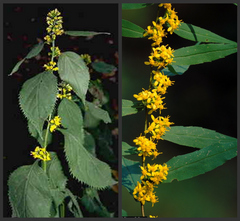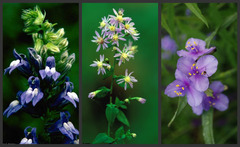Use your garden to show off your Wolverine school spirit

Smooth aster (Aster laevis) and Bluestem goldenrod (Solidago caesia) combine to give a blue and gold autumn cast to a residence.
Rick Meader | Contributor
But what about your garden? Doesn’t it deserve to join in the fun? Bright yellow marigolds in a blue pot are the obvious choice for a household, but what about some other more native options? Native plants that show your Wolverine school spirit and invite little flying friends to join the party are the subject of this week’s entry.
Maize. While the uniforms don’t really use the true color maize, that actually helps us in choosing the yellow portion of our living bouquet by giving us a wider array of yellows to use. Some options are:

Brown-eyed Susan (Rudbeckia triloba), Sneezeweed (Helenium autumnale) and Tall coreopsis (Coreopsis tripteris) can bring the yellow to your yard.
Sneezeweed photo (center) by Thomas G. Barnes @ USDA-NRCS PLANTS Database / Barnes, T.G., and S.W. Francis. 2004. Wildflowers and ferns of Kentucky. University Press of Kentucky. Brown-eyed Susan (left) and Tall coreopsis (right) by Rick Meader | Contributor.
Brown-eyed Susan (Rudbeckia triloba): This close relative of the black-eyed Susan (Rudbeckia hirta) blooms from July into October. It grows about 3’ tall and sports many bright, deep yellow flowers about 2” in diameter with a dark center. It grows well in a variety of moisture conditions (except wet) and light conditions, ranging from sunny to partial shade. It’s a biennial and self-seeds well.
Sneezeweed (Helenium autumnale): If you have wetter soils, you may want to try Sneezeweed. It was used as a treatment for a number of maladies by Native Americans, but the one where it probably got its common name was its use as a snuff to induce sneezing to help cure congestion. It likes full sun and grows from 3 to 5 feet tall. It blooms from August to October and has small sunflower-like flowers with very interestingly shaped petals (which are actually ray flowers). They’re triangular, with blunt teeth at the bottom.
Tall Coreopsis (Coreopsis tripteris): This is another plant with lighter yellow flowers that blooms from July into September. This grows from 4 to 7 feet tall and prefers full sun to partial shade with average soils, although I have a small stand that is in an area of fairly dry soil and partial shade that never gets full sun. This patch grows to about 5’ tall. Like the yellow-headed coneflower, both birds and butterflies make use of this plant.

Zig-zag goldenrod(Solidago flexicaulis and Bluestem goldenrod Solidago caesia can brighten up a shadier setting in your yard.
Zigzag goldenrod photo by Thomas G. Barnes @ USDA-NRCS PLANTS Database / Barnes, T.G., and S.W. Francis. 2004. Wildflowers and ferns of Kentucky. University Press of Kentucky. Bluestem goldenrod photo from http://www.npwrc.usgs.gov/resource/plants/floramw/species/soliflex.htm
Blue. We need blue! OK, here are a few:
Great blue lobelia (Lobelia siphilitica): This plant likes moister soils and grows up to 3 feet tall. It has a cluster of purplish-blue flowers along the stem at the top of the plant. It prefers sunny to partially shady conditions. This would be a good plant for a rain garden or a well-watered garden. It blooms from late summer into early fall.
Heart-leaved aster (Aster cordifolius) and Smooth Aster (Aster laevis): Heart-leaved aster is commonly found in open woods and has nice light-blue flowers forming at the top of the plant, which can grow from 1-4’ tall. It gets its name from its distinctive, heart-shaped leaves. In my partly shaded yard, it grows to about 2 feet tall, with the flower stem reaching to between 2 ½ feet and 3 feet tall. Smooth aster gets taller, to about 4-5’ tall and has light blue to lavender flowers. One trick with asters that get tall and gangly, such as smooth asters, is to cut the plant down to 2’ tall or so in June. It will still bloom in the fall, and have a shorter, bushier habit that is generally more pleasing in a garden setting.
Spiderwort (Tradescantia ohiensis): Well, we’re stretching the blooming season on this a bit, as it mainly blooms in summer (May-July), but it’s a great plant. It puts out a series of short-lived, deep blue flowers on a grassy-looking plant that grows from 2 to 3 feet tall. Look at the flowers in the early part of the day, though, because they close up by late afternoon. Some Native Americans would use the plant for treatment of female and kidney problems, as well as insect bites and cancer.

Great blue lobelia (Lobelila siphilitica), Heart-leaved aster (Aster cordifolius) and Spiderwort (Tradescantia ohiensis) offer various shades of blue for your yard.
Great blue lobelia and heart-leaved aster photos by Thomas G. Barnes @ USDA-NRCS PLANTS Database / Barnes, T.G., and S.W. Francis. 2004. Wildflowers and ferns of Kentucky. University Press of Kentucky. Spiderwort photo Rick Meader | Contributor
Non-native suggestions: OK, so I mentioned at the very start of this blog that I’m not totally opposed to using any non-natives in the landscape, and to get a deep blue/purple effect in your yard into the fall, you might try annual blue salvia or even multicolored blue/purple and yellow pansies to get a good blue (or quasi-blue) and gold effect. I can only offer these in good conscience as they’re not invasive. If you’re going to use these, please also use some of the native suggestions above to feed the multitude of insects that favor them.
Hopefully some of these will find their way into your garden to help your team spirit, and bring some of Wild Michigan near your home. You can buy most or all of the native plants I’ve suggested (and learn about more) at Native Plant Nursery in Ann Arbor, or at Wildtype Nursery, in nearby Mason.
Blooming in my yard this week are brown-eyed Susan, tall coreopsis, orange coneflower, ironweed, common evening primrose, Canada goldenrod, stiff goldenrod, virgin’s bower, white snakeroot, woodland sunflower and false sunflower. Starting to show some seed color are spicebush, jack-in-the-pulpit, spikenard, Solomon’s seal, false Solomon’s seal and spikenard. I also have a huge (to me) May apple - almost 2 1/2” in diameter. I’m sure a squirrel will find it soon.
Get out and enjoy nature, everyone!


Comments
Sarah Rigg
Mon, Sep 26, 2011 : 1:48 p.m.
I love this idea, Rick! My school colors growing up were orange and black - black seems like a tall order for a native plant. ;)